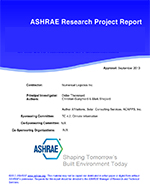Description
The object of ASHRAE Research Project 1299-RP was to investigate the links between filter efficiency, pressure drop, and energy consumption in residential and light commercial HVAC systems. The conventional wisdom is that higher pressure drop (and typically higher efficiency) filters will cause increased energy use. We investigated this claim with field measurements in seventeen forced air HVAC systems in occupied buildings and two controlled test systems in an unoccupied test house, as well as with a theoretical analysis.
On average, higher-efficiency (MERV 11-12) filters generally used slightly less energy than when compared to low-efficiency (MERV 2) filters in the field investigation. However, differences in energy use associated with different filters were not significant and were much smaller than differences that could be ascribed to climatic variation (particularly outdoor temperature) and changes in thermostat operation. The results from the unoccupied test house, which was much more controlled than the field monitoring, confirm the findings that the magnitude of potential energy impacts associated with higher-efficiency filters are very small. No significant difference in energy consumption due to higher-efficiency filters was observed in the two test house systems.
Overall, the results and analysis described in this report suggest that many of the energy consequences of higher-efficiency filters were small enough to be in the noise of variations of filters and installations and thus other factors should govern filter selection for residential and light commercial buildings. The results from the investigation allow for an accurate assessment of the energy consequences of filtration and provide information to ASHRAE membership, home and building owners, operators, designers and system installers to make decisions about higher-efficiency filtration.
Units: Dual
Product Details
- Published:
- 2010
- Number of Pages:
- 374
- File Size:
- 1 file , 3.1 MB
- Product Code(s):
- D-RP-1299




